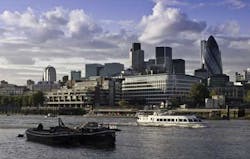Understanding LIBOR
Lie-BOR: What happens when the referee is also a player
Larry Hickey, FRM, Aneris XTRM, London
When I was a midshipman at the US Naval Academy, a lot of guys wanted to be fighter pilots. If they were allowed to choose based purely on class rank, the best and brightest would be lured into the sexy world of aviation when the Navy had more mundane but pressing needs. So the Navy decided that midshipmen must have perfect vision to fly. There was no operational need for this requirement. If an aviator’s eyes went bad after the Navy had spent millions on his training, he could still fly. The requirement existed solely to prevent a "brain drain into aviation and the eye exam became a high stakes barrier to entry for those dreaming of gold wings.
Doctors administered the eye exam. But what if they instead simply asked each midshipman to report his vision on the honor system?
Don’t laugh. That’s akin to the arbitrary mechanism by which Libor is set. And now, like the piano player at a cathouse, we are shocked, shocked to learn what has been going on. There are allegations of cheating.
Libor is the London Interbank Offered Rate. It is the rate that banks expect to pay on USD loans. Other currencies and a range of terms are also included, but we’ll focus on a single USD rate here. Libor is derived from self-reported rates from a group of banks. It is only an indication. No actual borrowing has to take place. So there is ample room for judgment, bias, and the usual panoply of human foibles.
Here’s how it works. At 11 am each weekday, 18 banks send estimates of what they would have to pay to borrow money to Thomson Reuters. The numbers are lined up from top to bottom. The top and bottom four are discarded and the rest are averaged. Libor is that average and it is used as a benchmark rate – reflecting only interbank credit risk – for other USD rates. Libor is published daily at 11:30 am under the auspices of the British Banker’s Association.
Skin in the game
Just as aspiring aviators desire perfect vision, banks want to appear healthy. Banking is a very risky business with a structural flaw. Long-term assets (loans) are funded by short-term liabilities (deposits), which can be withdrawn at any time. The mere hint of weakness could trigger a sudden withdrawal, called a run on the bank, which would necessitate either a bailout or collapse. Perception can quickly become reality. The interest rate at which other institutions are willing to loan the bank money is a measure of the bank’s perceived health, its creditworthiness. So the lower the rate, the better.
Who did what?
Barclays was the first name to pop up, paying a $450 million penalty and bidding adieu to their top brass. Between 2005 and 2009, Barclays traders made 257 requests to fix Libor and Euribor, according to the UK’s Financial Services Authority (FSA). Before the banking crisis, the manipulation was in both directions as Barclays traders made up to $40 million a day on interest rate derivatives by skewing Libor rates. But as the banking crisis took hold in 2007, perceptions of the bank’s health became the dominant concern and the manipulation was exclusively to the downside. Senior treasury managers instructed the troops to reduce Libor to avoid negative attention. Per the FSA report, Barclays should not ‘stick its head above the parapet’. And with that, we came to learn the difference between ‘clean, clean’ and ‘dirty, clean.’ Twenty other banks are under investigation and collusion is specifically alleged.
Dwarfs all other financial scandals
The total value of securities and loans affected by Libor is estimated at $800 trillion annually. That’s about 10 times the value of all goods and services that will be produced on the planet this year. A 2007 email to the NY Fed alleged a seven basis point mispricing by Lloyd’s. If seven pips was the average mispricing, we’re looking at an annual error of $560 billion or about $2 trillion over the four years the scam is alleged to have run. That number must be adjusted to allow for offsetting positions, positions held within the gang, jurisdictional and standing restrictions, and the treble damages allowed under US antitrust rules. Net estimates of bank liability for the scam are all over the map, ranging from $6 billion to $300 billion.
A view of London’s financial district from the Thames River.
Pretending to be asleep at the wheel
This scam is all the more pernicious because regulators were allegedly aware of it. Bank of England (BoE) governor Sir Mervyn King and US Treasury Secretary Tim Geithner discussed problems in the way Libor was set in early 2008. A 2008 Barclays internal email documenting a phone call with the BoE notes that "a number of senior figures in Whitehall were troubled by Barclays’ relatively high Libor quotes following the collapse of Lehman. When Bob Diamond noted that not all banks were providing quotes at the levels that represented real transactions, the BoE representative’s response was, "Oh, that would be worse. Again, according to Bob Diamond, who is now Barclays’s ex-CEO.
Recall that at the same time the Fed and the BoE were trying to drive down rates to mask the insolvency of their respective banking systems. So telling the banks to stop rigging Libor and selling interest rate swaps may have been a lower priority. The scam was contributing to the success of the regulators’ own policies. They were all rowing in the same direction.
Who got done?
If you borrowed money keyed off Libor between 2007 and 2010, you may have benefited. But if you loaned money based on Libor, you probably got taken. One popular means of exporting the scam was through interest rate swaps. If you paid a fixed rate and received a floating rate based on Libor, you likely got done. The US taxpayer is a notable victim because both the $182 billion bailout of AIG and a $1 trillion emergency lending program called the Term-Asset Backed Securities Loan Facility were linked to Libor.
Whack-a-mole
The Libor rate setting mechanism is fatally flawed. Without any basis in an actual transaction, it is too easy to manipulate. Focusing on which particular entity actually did the manipulation may be beside the point, especially when participation appears to have been so widespread. Yes, the cars were stolen and we should punish the thieves. But we should also lock the doors and remove the keys from the ignitions going forward. There is insufficient honor among thieves for the current system to work.
About the author
Larry Hickey is a managing director with Aneris XTRM, certified risk manager and frequent contributor to these pages. He has spent the past 14 years managing implementations of industry leading ETRM solutions. He is frequently called upon to turn around troubled projects.


